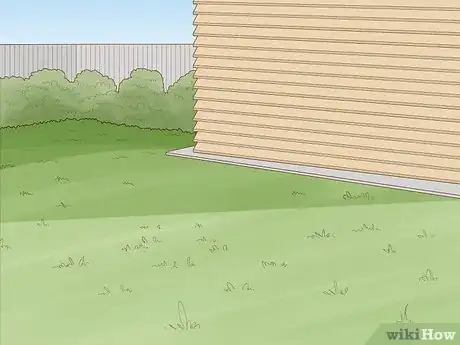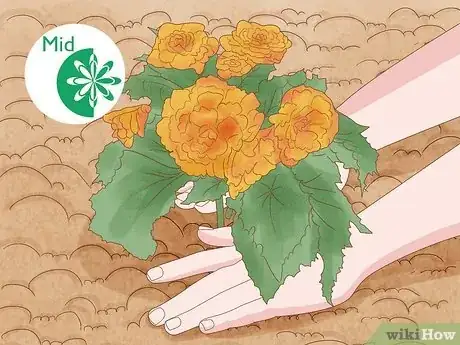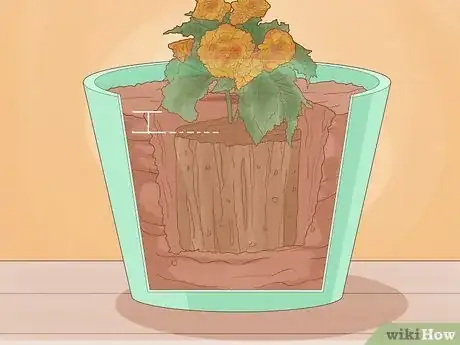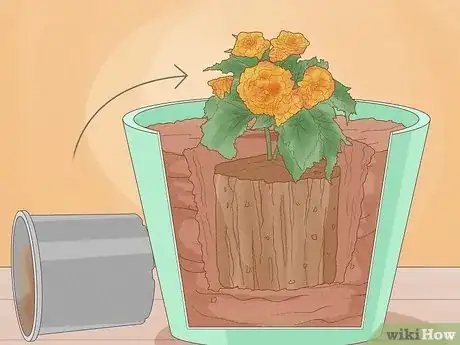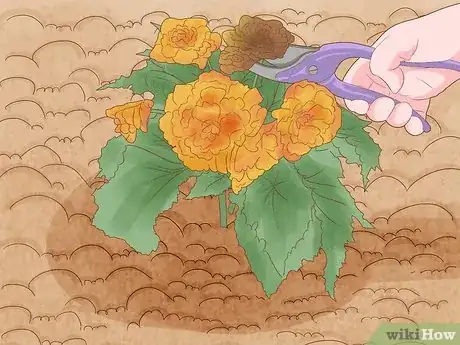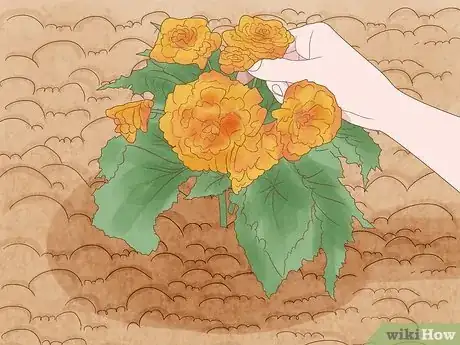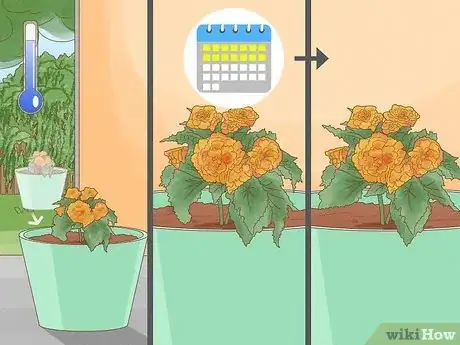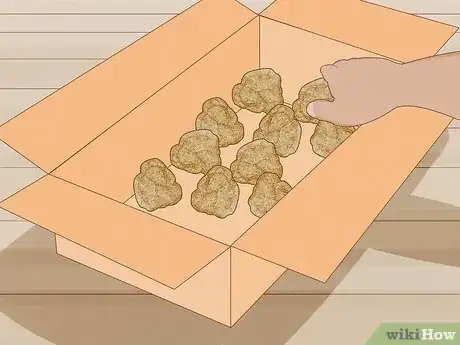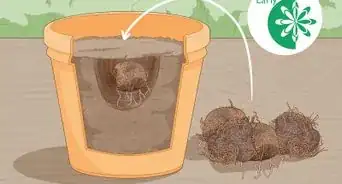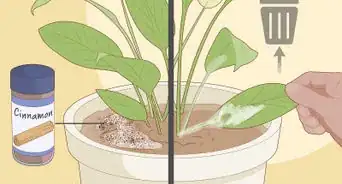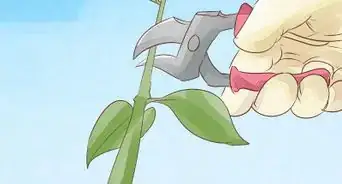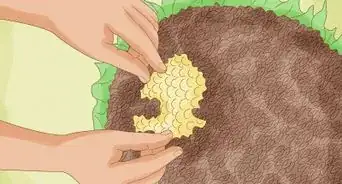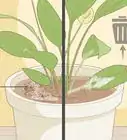This article was co-authored by Katie Gohmann. Katherine Gohmann is a Professional Gardener in Texas. She has been a home gardener and professional gardener since 2008.
wikiHow marks an article as reader-approved once it receives enough positive feedback. In this case, 100% of readers who voted found the article helpful, earning it our reader-approved status.
This article has been viewed 343,212 times.
Begonias are a classic gardeners' favorite for their ease of growing and beautiful color. Whether you want a new houseplant to add to your collection, something to add to your hanging baskets, or a new addition for your outdoor garden, consider planting begonias. Begonias typically grow 8-15 inches (20-38 cm) tall and equally as wide. Although they are annuals that require yearly replanting, they are well worth the effort.
Steps
Preparing to Plant
-
1Select a type of begonia to plant. There are two general types of begonias: those grown from seeds, and those grown from tubers/bulbs. The seed-started begonias tend to be a bit smaller and difficult to grow, while bulb begonias are sturdier and larger plants. Both varieties come in many color options including shades of pink, white, purple, yellow, and red. Bulb and seed begonias are annuals, although the bulbs can be saved and replanted in later years. Growing begonias from seeds or bulbs is quite difficult, so it is recommended that you head to your local nursery to pick up a small potted begonia to transplant.
- In rare opportunities, you may find a type of perennial begonia, but these aren’t common.
- You can choose to start begonias from cuttings as well.
-
2Choose a location. Begonias are one of many common flowers that can be grown successfully both indoors and outdoors. They like light or dappled (rather than full) shade, making them the perfect addition to your houseplant collection. If you plant your begonias in a pot, choose a location in your house on an eastern, western, or southern facing window. They can also be placed on a shaded porch, which gets plenty of ambient sunlight. If you’re planting them in garden, place them in a shady patch under other larger plants or on the northern side of your garden.
- Begonias can handle partial sun, but avoid placing them in direct sunlight. Also, red-leaved begonias handle heat better than green-leaved begonias.
- If the shade is too dense, your begonias won’t grow properly. Choose an area with indirect sunlight and partial shade.
- If you don’t have any indoor window space for potted begonias, you’ll need to use a fluorescent lamp in order to provide them with a bit of light.
Advertisement -
3Prepare your soil. Rather, don’t prepare soil at all, as begonias grow better in soil-free garden mix than then do in typical ‘dirt’. Prepare a mixture of ⅔ peat moss and ⅓ soil-free potting mixture (available at gardening supply stores and nurseries). Begonias like acidic, well-draining environments which the peat moss mixture easily provide. If you must use soil outside, incorporate plenty of peat moss and organic matter into the soil to provide the best environment for your begonias.
- If you use a peat moss mixture, soak the moss in boiling water and allow it to cool prior to planting the begonias.
- You can use a 20-20-20 liquid fertilizer on your soil/soil mixture for some added nutrients for the begonias.
-
4Know when to plant. Begonias are annuals, so they won’t grow back each year. Therefore, each year you will have to replant them, typically in mid spring. Begonias don’t handle cold temperatures and frost well, so wait until at least one week after the final frost of winter to plant them. If nothing else, plant them in a pot early indoors, and then transplant them outdoors when the weather warms up.[1]
Planting Your Begonias
-
1Prepare your garden plot/container. If you are planting your begonias outside, dig a hole a few inches deep for seeds and bulbs, or large enough to cover the root ball of a potted plant. Begonias that are going to be placed in raised beds or pots should be given a container only slightly larger than their root ball, or intermixed in a larger container with other potted plants. Begonias don’t need much space, so feel free to plant them closely to other plants in your garden, or near the edge of your pot/bed.
-
2Plant your begonias. Remove the bulbs, seeds, or transplant and place it in the hole you’ve dug. Each begonia plant should be placed in its own hole, although these can be put close together. Cover the top of the root ball, bulb, or seeds with a few inches of soil/potting mixture. If you’re planting a small begonia plant, break apart the root ball a bit before placing it in the hole.
-
3Water the plant. Most plants need a bit of extra watering after first being planted, in order to avoid what is known as ‘transplant shock’. Give your begonias a heavy watering, so that the soil is moist but not drenched. The flowers will need to be watered every few days from there on, either manually or with a sprinkler system. Begonias don’t tolerate heavy waterings well, so keep the soil moist but not wet. In fact, if it rains heavily in your area, you may have to move your begonias onto a porch or indoors to prevent them from drowning.
- Be sure to water at the base of the plant, rather than directly on the leaves. Also, don’t mist your begonias.
-
4Maintain the garden plot. If you planted your begonias in a pot on your porch or indoors, you won’t have to deal with weeds much. However, if your plants are in an outdoor garden, check for weeds every few days and pull them out. Add a 20-20-20 liquid fertilizer about once a month, or mix in a bit of compost and peat moss for added nutrients. You can choose to mulch your garden if you would like, as this will trap moisture (meaning less frequent waterings) and prevent new weeds from sprouting.
-
5Deadhead the begonias. Over time, you’ll notice that the flowers on the begonia plant will begin to brown and die. At this point, you should do a process known as ‘deadheading’. This involved cutting or pulling off the dead flower head, so as to promote new growth and divert nutrients to other parts of the plant. At the end of the blooming season, remove all the dead buds and leave the green plant. This way, the nutrients the plant gathers will all be stored in the bulb for the next growing season, rather than going to help the flower buds that are already dead.
-
6Protect your plants from pests. Although outdoor plants are always at risk for abuse from nature, indoor plants can become pest-ridden as well. Keep your begonias safe from slugs and snails outdoors by crushing eggshells and placing them around the base of the plant. Indoor plants often become infested with mealy bugs, which can be killed with a bit of regular rubbing alcohol in a spray bottle. Other pests can be done away with a mild insecticide used for gardening. Talk to a local nursery worker to get advice on the best method for your begonias.
-
7Pick your begonias. Begonias aren’t typically used in floral arrangements because they lack long stems, but you can pick the flowers for decorative uses such as pressings. Pinch or pluck the flower from the top of the greenery, avoiding taking too many leaves/too much of the stem with it. You can pick as many as you like during the growing season, as they should grow back after several days.
-
8Protect the plants from the cold. If your plants aren’t dead when it begins to freeze outside, you can save them by bringing them indoors. This really only works for potted plants outdoors, though. Place the pots in a window that gets lots of sunlight. For the first 1-2 weeks indoors, the begonias will drop lots of leaves, but this is normal for being transplanted. They should be good as new after acclimating to their new environment.
-
9Save the bulbs. At the end of the year when your plants are all preparing for the winter, you can save the bulbs from your begonias to replant the following spring. Wait until the plant has completely browned, and then pull all the major stems/leaves from the bulb. Put the bulb(s) onto a grate or screen in a cool, dry area to dry out for 5-7 days. When they are totally dry, they can be put away for storing. The bulbs should then be placed in a cardboard box full of dry peat moss until they are ready to be replanted in the spring.[2]
Expert Q&A
Did you know you can get expert answers for this article?
Unlock expert answers by supporting wikiHow
-
QuestionDo I need to dig them up every year?
 Katie GohmannKatherine Gohmann is a Professional Gardener in Texas. She has been a home gardener and professional gardener since 2008.
Katie GohmannKatherine Gohmann is a Professional Gardener in Texas. She has been a home gardener and professional gardener since 2008.
Professional Gardener
-
QuestionAre they indoor or outdoor plants?
 Community AnswerBegonias can be grown both ways, provided they get the necessary environment. If grown indoors, they can be placed near a window, or in a porch. If grown outdoors, they should be placed in partial shade.
Community AnswerBegonias can be grown both ways, provided they get the necessary environment. If grown indoors, they can be placed near a window, or in a porch. If grown outdoors, they should be placed in partial shade. -
QuestionI planted my begonias a month ago and they're still not growing. What should I do?
 Gwyn DuhonCommunity AnswerPut your old coffee grinds in with the soil, you will be amazed.
Gwyn DuhonCommunity AnswerPut your old coffee grinds in with the soil, you will be amazed.
Things You'll Need
- Peat moss
- Sand
- Fertilizer
- Water
- Garden hoe
- Container with drainage holes
- Hanging baskets
- Begonia bulbs, seeds or transplants
References
About This Article
If you want to grow begonias, choose a shady spot that gets some dappled light. If you’re planting the begonias in a pot, plant them in a mixture of peat moss and soil-free potting mixture. If you want the begonias to grow outside, mix peat moss and organic matter into your soil, then dig a hole big enough to cover the root ball of the plant. Plant the begonias in mid-spring, and water them every few days so the soil stays moist but not wet. Keep reading for tips from our horticulture reviewer on pruning your begonias!

